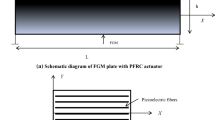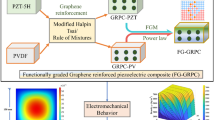Abstract
Finite element-based simulations have been performed on piezoelectric-based functionally graded materials (FGM). PZT (Lead zirconate titanate) and PVDF (Polyvinylidene fluoride) FGM composites have been investigated. Anomalous enhancement in output voltage has been observed at grading index n = 0.05 (Voltage = 210 V), which is 105 and 185% higher than the original material at n = 0 (PVDF) and n = ∞ (PZT), respectively. Further, role of Young’s modulus, dielectric constant, and piezoelectric constant was systematically investigated to understand this enhancement. It is found that performance of FGM not only relies on piezoelectric constants but also largely depends upon values of Young’s modulus and dielectric constant.






Similar content being viewed by others
References
Dong L, Zhao G, Xiong C, Quan H (2009) Effect of piezoelectric particles size distribution on electric properties of PZT/PVDF composites. Acta Mater Compos Sin 4:012–015
Rodel J, Webber KG, Dittmer R, Jo W, Kimura M, Damjanovic D (2015) Transferring lead-free piezoelectric ceramics into application. J Eur Ceram Soc 35(6):1659–1681
Hong C-H, Kim H-P, Choi B-Y, Han H-S, Son JS, Ahn CW, Jo W (2016) Lead-free piezoceramics—Where to move on? J Materiomics 2(1):1–24
Saito Y, Takao H, Tani T, Nonoyama T, Takatori K, Homma T, Nagaya T, Nakamura M (2004) Lead-free piezoceramics. Nature 432(7013):84–87
Rödel J, Jo W, Seifert KT, Anton EM, Granzow T, Damjanovic D (2009) Perspective on the development of lead-free piezoceramics. J Am Ceram Soc 92(6):1153–1177
Ueberschlag P (2001) PVDF piezoelectric polymer. Sens Rev 21(2):118–126
Vinogradov A, Holloway F (1999) Electro-mechanical properties of the piezoelectric polymer PVDF. Ferroelectrics 226(1):169–181
Ploss B, Ploss B, Shin FG, Chan HLW, Choy CL (2000) Pyroelectric or piezoelectric compensated ferroelectric composites. Appl Phys Lett 76(19):2776–2778
Chan HLW, Zhang QQ, Ng WY, Choy CL (2000) Dielectric permittivity of PCLT/PVDF-TRFE nanocomposites. IEEE Trans Dielectr Electr Insul 7(2):204–207
Han P, Pang S, Fan J, Shen X, Pan T (2013) Highly enhanced piezoelectric properties of PLZT/PVDF composite by tailoring the ceramic Curie temperature, particle size and volume fraction. Sens Actuators A 204:74–78
Kuang D, Li R, Pei J (2014) Polyamide 11/poly (vinylidene fluoride)/vinyl acetate-maleic anhydride copolymer as novel blends flexible materials for capacitors. Polymers 6(8):2146–2156
Yao L, Zhao HD, Dong ZY, Sun YF, Gao YF (2012) Laboratory testing of piezoelectric bridge transducers for asphalt pavement energy harvesting key engineering materials. Trans Tech Publ 492:172–175
Santos IA, Rosso JM, Cótica LF, Bonadio TG, Freitas VF, Guo R, Bhalla AS (2016) Dielectric and structural features of the environmentally friendly lead-free PVDF/Ba 0.3 Na 0.7 Ti 0.3 Nb 0.7 O 3 0-3 composite. Curr Appl Phys 16(11):1468–1472
Sharifi Olyaei N, Mohebi MM, Kaveh R (2017) Directional properties of ordered 3‐3 piezocomposites fabricated by sacrificial template. J Am Ceram Soc 100(4):1432–1439
Topolov VY, Bowen C, Bisegna P, Krivoruchko A (2015) New orientation effect in piezo-active 1–3-type composites. Mater Chem Phys 151:187–195
Xu D, Du P, Wang J, Hou P, Huang S, Cheng X (2016) Design and properties of Gaussian-type 1–3 piezoelectric composites. Compos Struct 140:213–216
Topolov VY, Bisegna P, Bowen CR (2014) Orientation effects and anisotropy of properties in 2–2 and related composites, piezo-active composites. Springer, Berlin, pp 43–88
Steinhausen R, Pientschke C, Seifert W, Beige H (2004) In: IEEE Ultrasonics Symposium 2004. Finite element analysis of the thickness mode resonance of piezoelectric 1-3 fibre composites, pp. 1678–1681
Akdogan EK, Allahverdi M, Safari A (2005) Piezoelectric composites for sensor and actuator applications. IEEE Trans Ultrason Ferroelectr Freq Control 52(5):746–775
Topolov VY, Bisegna P, Bowen CR (2013) Piezo-active composites: orientation effects and anisotropy factors. Springer, Berlin
Nan C-W, Weng G (2000) Influence of polarization orientation on the effective properties of piezoelectric composites. J Appl Phys 88(1):416–423
Lam K, Chan H (2005) Piezoelectric and pyroelectric properties of 65PMN-35PT/P (VDF-TrFE) 0–3 composites. Compos Sci Technol 65(7):1107–1111
Ren H, Fan H (2006) The role of piezoelectric rods in 1–3 composite for the hydrostatic response applications. Sens Actuators A 128(1):132–139
Wu C, Kahn M, Moy W (1996) Piezoelectric ceramics with functional gradients: a new application in material design. J Am Ceram Soc 79(3):809–812
Wu X-H, Chen C, Shen Y-P, Tian X-G (2002) A high order theory for functionally graded piezoelectric shells. Int J Solids Struct 39(20):5325–5344
Zhu X, Meng Z (1995) Operational principle, fabrication and displacement characteristics of a functionally gradient piezoelectric ceramic actuator. Sens Actuators A 48(3):169–176
Zhong S, Ban Z-G, Alpay SP, Mantese JV (2006) Large piezoelectric strains from polarization graded ferroelectrics. Appl Phys Lett 89(14):142913. doi:10.1063/1.2358963
Nath R, Zhong S, Alpay SP, Huey BD, Cole MW (2008) Enhanced piezoelectric response from barium strontium titanate multilayer films. Appl Phys Lett 92(1):012916. doi:10.1063/1.2825287
Misirlioglu IB, Alpay SP (2017) Compositionally graded ferroelectrics as wide band gap semiconductors: electrical domain structures and the origin of low dielectric loss. Acta Mater 122:266–276
Ghosh M, Rao MG (2013) Growth mechanism of ZnO nanostructures for ultra-high piezoelectric d 33 coefficient. Mater Express 3(4):319–327
Shaikh AS, Vest RW, Vest GM (1989) Dielectric properties of ultrafine grained BaTiO/sub 3. IEEE Trans Ultrason Ferroelectr Freq Control 36(4):407–412
Li R, Xue B, Pei J (2015) Enhancement of the dielectric performance of PA11/PVDF blends by a solution method with dimethyl sulfoxide. e-Polymers 15(6):439–445
Hosseini-Hashemi S, Taher HRD, Akhavan H, Omidi M (2010) Free vibration of functionally graded rectangular plates using first-order shear deformation plate theory. Appl Math Model 34(5):1276–1291
Erturk A, Inman DJ (2011) Piezoelectric energy harvesting. John Wiley & Sons, Hoboken
Kumar A, Sharma A, Kumar R, Vaish R, Chauhan VS (2014) Finite element analysis of vibration energy harvesting using lead-free piezoelectric materials: a comparative study. J Asian Ceram Soc 2(2):138–143
Acknowledgement
Rahul Vaish thanks Indian National Science Academy, New Delhi for financial support.
Author information
Authors and Affiliations
Corresponding author
Appendix
Appendix
To model the piezoelectric structure, finite element method has been used. For this study, script of finite element formulation has been written in MATLAB software. The 3D element has been chosen to discretize the piezoelectric cube. 3D element has three mechanical degrees of freedom (u, v, w) and one electrical degree of freedom (V).
In 3D solid element, any point coordinate (x, y, z) within the cube can be written as:
where N i is the shape function and nnel is number of node in element. x i , y i , and z i are coordinates of the ith node of element.
Similarly, displacement and voltage field can be written as:
u i , v i , and w i are mechanical degrees of freedom and V is electrical degree of freedom in element at the node.
Strain and electrical field can be written as
where n is total number of nodes.
Strain energy in element:
where
Electrical energy in element:
where
Kinetic energy in element:
where
N are the shape functions.
Total external work done on the element:
S 1 = surface area on which external force is acting, S 2 = surface area of piezoelectric layer where applied electric charge is acting, \( \left\{ {f_{s} } \right\} \) = surface force intensity, \( \left\{ {f_{p} } \right\} \) = point load, \( \left\{ {f_{q} } \right\} \) = surface electrical charge density
By using Hamilton’s principle as final equations can be written as
Using Eqs. (13), (14), (15) and (16)
In this study, static case has been considered which reduced the equation further by removing the dynamic force terms (inertia force and damping force)
As there is no external electrical force applied (Q = 0) final equation can be written as
Using these equations displacement and voltage can be calculated.
Rights and permissions
About this article
Cite this article
Kumar, A., Sharma, A., Vaish, R. et al. A numerical study on anomalous behavior of piezoelectric response in functionally graded materials. J Mater Sci 53, 2413–2423 (2018). https://doi.org/10.1007/s10853-017-1719-9
Received:
Accepted:
Published:
Issue Date:
DOI: https://doi.org/10.1007/s10853-017-1719-9




